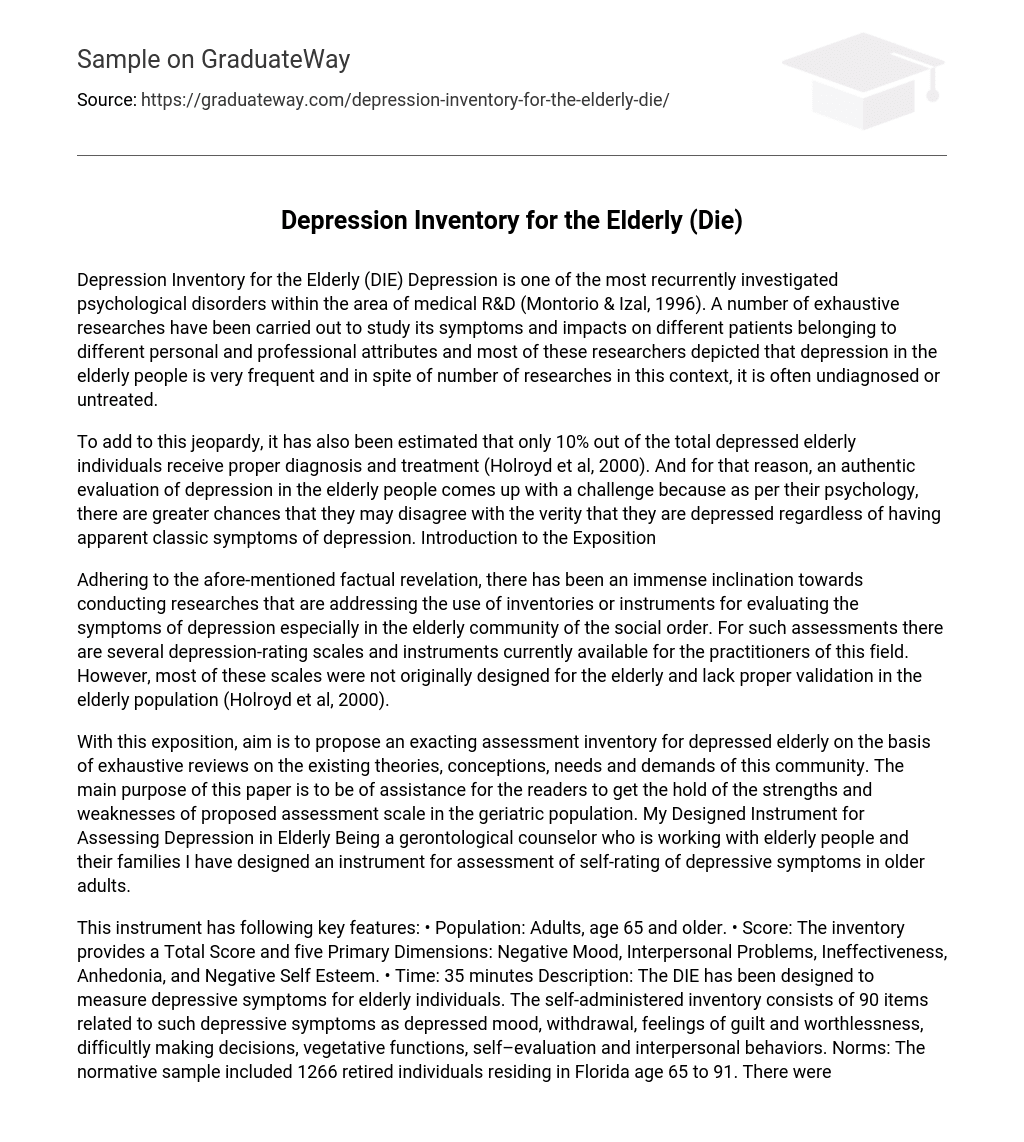The Depression Inventory for the Elderly (DIE) is extensively studied in medical research and development, with a focus on a frequently researched psychological disorder. Many comprehensive studies have explored the symptoms and impacts of depression on individuals with diverse personal and professional characteristics. The results consistently demonstrate a significant occurrence of depression among elderly individuals, often without receiving proper diagnosis or treatment.
According to research conducted by Holroyd et al (2000), accurately diagnosing and treating depression in older adults is a significant challenge. The study found that only about 10% of elderly individuals with depression are correctly diagnosed and treated. This presents a problem as many older adults refuse to acknowledge their condition, even though they exhibit clear symptoms. Thus, this statement serves as an introduction for the upcoming discussion.
Research has focused on the use of inventories or instruments to evaluate depression symptoms in the elderly. Depression-rating scales and instruments are available for this purpose, but many were not originally designed for the elderly and lack validation in this population (Holroyd et al, 2000).
Our goal is to suggest a thorough evaluation inventory for depressed elderly individuals, based on extensive research into existing theories, concepts, needs, and desires within this community. This paper aims to provide readers with an understanding of the pros and cons of the suggested assessment scale for older people. As a gerontological counselor specializing in working with elderly individuals and their families, I have personally created a tool for assessing self-reported depressive symptoms in older adults.
The DIE (Depression Inventory for the Elderly) is an instrument designed to assess depressive symptoms in adults aged 65 and older. It consists of 90 items related to various aspects of depression, such as depressed mood, withdrawal, guilt, worthlessness, decision-making difficulties, vegetative functions, self-evaluation, and interpersonal behaviors. The inventory provides a Total Score and five Primary Dimensions: Negative Mood, Interpersonal Problems, Ineffectiveness, Anhedonia, and Negative Self Esteem. Scoring is based on a 5-point distress scale (0-4), with higher scores indicating greater distress levels.
A normative sample of retired individuals from Florida aged 65 to 91 was used in the study. They were mostly middle to upper-class retirees. Hand scoring was done on the results, with T scores above 65 on both the Total Score and Primary Dimensions considered within the “clinical range.” The reliability of the inventory is satisfactory with internal consistency ranging from .71 to .89 in different samples.
According to the text’s findings about depression symptoms varying over time and regression of mean being linked to repetitive testing; three research studies have examined the accuracy of using DIE for evaluating concurrent and predictive constructs specifically in identifying depression symptoms among older individuals. These studies confirm that DIE effectively distinguishes between those who are depressed and those who are not.
The proposed instrument, the DIE, is currently being evaluated based on three main attributes: Appropriateness, Strengths, and Weaknesses.
In terms of appropriateness, as a gerontological counselor, I believe the proposed DIE is well-suited for my clients who are primarily older individuals above 65 years old and retired. It aligns well with the population I work with, making it suitable within my counseling domain. Furthermore, its reliability and validity make it even more appropriate for use in this field of counseling.
Moving on to strengths and weaknesses, the designed DIE aims to assess levels of depression in patients by taking into account various aspects of depression. It’s crucial to acknowledge that this instrument possesses both strengths and weaknesses.
This assessment has a key benefit – it can evaluate the severity of depression in adults diagnosed with a psychiatric condition. Unlike other assessments that only rely on patient responses to traditional questions, this assessment yields more meaningful results. Nonetheless, it does have a drawback: it takes longer to complete than other depression assessment scales.
The proposed DIE is being recommended due to its unique features. After evaluating its capabilities, I believe this tool encompasses all aspects and I plan to incorporate it into my counseling practices. By using this tool, I aim to generate unconventional diagnostic results that will enhance the effectiveness and realism of my services.
References:
Holroyd, M. D., Anita, H. Clayton, M. D. (2000). Measuring depression in the elderly: Which scale is best? Medscape General Medicine, 2(4).
Montorio, I. & Izal, M. (1996). The geriatric depression scale: A review of its development and utility. Retrieved February 24, 2012, from http://www.public-health.uiowa.edu/icmha/outreach/documents/TheGeriatricDepressionScale.pdf.





